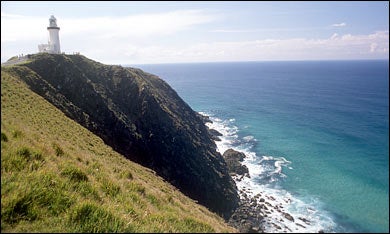Australia’s fabled surfie hangout emerges as a multisport playground Byron Bay may be the modern surfer’s idyll—Australia’s most consistent waves pound the white sands around Cape Byron, which rises like a giant snake’s head from the blue Pacific—but veterans of the sport still reminisce about the days preceding its discovery. Indeed, there was a time before the late sixties when the hippies, Buddhists, Hare Krishnas, and naturists of all stripes flocked to the easternmost point of Australia, 570 miles north of Sydney. This fabled era, when Byron Bay was a working-class town supported by logging, dairy farming, and whaling, evidently had its pluses and minuses.
Consider the salutary tale of Bob and Terry, a couple of Sydney beach bums who in 1962, at the height of the Cuban Missile Crisis, tossed their malibus onto a train and made their escape to Byron Bay. Picked up by a friendly passerby at the railway station (“G’day—did you come to find some waves?”), they spent a day riding the perfect swells at an empty beach called Watego’s. It seemed to them a reasonable approximation of paradise. Unfortunately, local cops roared into their campsite, grabbed them by the hair, gave them a short-back-and-sides trim, and then dropped them on a road out of town.
But 40 years is a long time in Aussie beach culture. Not long after Bob and Terry got rolled, redneck Byron Bay became Australia’s countercultural Shangri-La—a half-mythic place where surfers could park in their panel vans by the beach, sign on for the dole, and live on a diet of bananas, fish ‘n’ chips, and illicit local herbs. Today, surfing is not only respectable at Byron Bay; it’s downright establishment. In fact, while I was reading Bob and Terry’s Easy Rider tale—I was at the scene of the crime, Watego’s Beach, flipping through an ancient copy of Pacific Longboarder magazine—a svelte surfie couple dropped their boards outside the lone restaurant, where they chowed down on Thai prawn salad and Tasmanian champagne.
Yes, there are the occasional whiffs of a Hamptons Down Under, but Byron Bay has in fact blossomed in a uniquely Australian, democratic way, balancing its competing interests to keep a low-rise beach paradise intact. To get the lay of the land, newcomers should nurse a schooner of beer at the area’s most famous pub, the Beach Hotel. You can play at being a celebrity in hiding—Keith Richards had left just before I arrived in March—or join the international backpacker set on the beach at night, spinning fire sticks as if practicing for Cirque du Soleil. You can eat from sushi bars or vegan buffets, catch an art-house movie, or browse for local indie-rock CDs. And the Aquarian spirit is alive and well: Yoga classes are held at dawn on the beach, crystals are revered in souvenir shops, and radicals are given full voice. (I opened the official tourist guide and enjoyed a lurid essay on the Iraqi war.) Somehow it all seems right in the eclectic Byron Bay soup.
The good news for outdoor fans is that Byron Bay has branched out from surfing—reinventing itself as the Boulder of the South, Telluride on a warm beach. The wonder is that it has taken so long, given the setting: The offshore waters host some of the most fertile marine grounds in Australia, while the mountain hinterland of the Great Dividing Range is thick with subtropical rainforest. Right now, Byron Bay’s outfitters are making up for lost time. I strolled through the compact village one afternoon—the adventure companies are clustered together in rabid competition, with names like Wicked Travel and Cape Fear—and within an hour I had signed on for a decathlon of Aussie outdoor escapades, covering land and sea. Admittedly, I skipped the naked bushwalking for beginners, but I was up for everything else, on day trips led by itinerant Aussie guides, many of whom seemed to be on sabbatical from snowboarding in the Canadian Rockies.
For starters, Nightcap National Park, 25 miles inland, has miles of mountain-bike trails, from easy to hardcore. On a wet morning, a sunburned surfer named Lindsay led ten of us through the mist-filled rainforest, where eucalyptuses soared like Grecian columns. The 13 miles I covered felt more like 50, feathering down or grinding up, skidding over sinuous roots, taking in grandiose vistas and secret swimming holes.
With just as much zeal, the Zodiacs slip like sea iguanas off Clarks Beach every dawn. In November 2002, a stretch of the Coral Sea, along Byron Bay’s beaches from Brunswick Head to Lennox Head, was declared the Cape Byron Marine Park; a mile and a half offshore, an outcrop called Julian Rocks is rated one of Australia’s top ten diving spots, thanks to the thriving piscine community lured by the confluence of warm and cool currents. A dive master named Evan—crew-cut, tongue-pierced, tattooed like a Polynesian sailor—led the underwater trail past squadrons of butterfly fish and angels to the scene-stealers of the dive: moray eels, loggerhead turtles, eagle rays flapping batlike overhead, and ten-foot leopard sharks that drifted so close my fingers brushed their flanks, strangely rough as sandpaper. (In winter, gray nurse sharks pass through—keep your distance.)
Why stop there? I thought. The next morning came a ride on a microlite—Byron Bay’s latest craze, a motorized hang glider that soars above the activity—and, of course, I signed up for a surfing lesson. This is still the number-one breadwinner for Byron Bay’s outdoor operators, thanks to water temperatures that fluctuate between 65 and 81 degrees and strong year-round swells producing waves between three and six feet tall. Here, a surf scene materializes wherever there is a stretch of sand. The most coveted spots include Cosy Corner and Tallow’s, on the south side of Cape Byron, where bushland and the cornflower-blue sea collide. And picturesque Watego’s, the most easterly beach in Australia, still tops the charts for where to see and be seen.
Back home in New York, color-coded terrorist alerts were going from yellow to orange. Here in Byron, they also employ color coding. Like schools of fish, surfing students are grouped by the color of their wetsuits. As I proceeded to learn the difference between riding goofy and natural—hopping on my padded board, falling off, hopping on again—the rest of the world seemed very, very remote.
DETAILS:
Lodging: Experienced Byron hands stay at a beach called Belongil Spit—it’s away from the center of town, has great cafés, and you can walk along the sand for 15 minutes to reach the action. Belongil by the Sea has four cottages that sleep two to nine, with kitchens, on two acres of botanical gardens, starting at $63 a night (011-61-2-6685-8111, ). Film stars prefer Rae’s On Watego’s (rooms start at $145; 011-61-2-6685-5695, ).
Sports: There is good beginner surfing year-round in Byron Bay. For lessons, try Black Dog Surfing, a school that runs beginner classes several times a day ($30 per three-hour group lesson; 011-61-2-6680-9828, ). The more experienced can take private lessons from former U.S. surf champion, longtime Byron Bay resident, and local celeb Rusty Miller (a two-hour private lesson costs $56 for one person, $99 for two; 011-61-2-6684-7390, rustym@mullum.com.au). Besides surfing, the whole gamut of outdoor sports is on offer in Byron Bay—operators line Jonson Street and the competition keeps prices down. Rockhoppers (011-61-2-6680-8569, ) runs mountain-biking trips ($52 for a solid day), hikes to watch the sunrise from 3,800-foot Mount Warning ($39), and caving/rappelling trips ($79). Byron Bay Dive Centre (011-61-2-6685-8333, ) takes divers out every morning to Julian Rocks ($50 per single-tank dive). Hang-glide or microlite with Skylimit ($92 for a tandem flight; 011-61-2-6684-3711, ).
The Dish on Soup Bowl
In Barbados, Surf Kings Happily Serve Up Lessons for Plebes
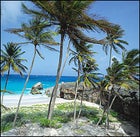 Barbados sports a tight-knit surfing community and a refreshing lack of attitude
Barbados sports a tight-knit surfing community and a refreshing lack of attitudeIn stuffy Barbados, where islanders worship cricket and neckties flourish, the unlikely badass surf scene is a splash of hot pepper sauce on the otherwise bland national dish: flying fish with okra-and-cornmeal mash. The Caribbean’s most consistent waves roll in from the east, pounding the pear-shaped, 166-square-mile island, the easternmost outpost of the West Indies. And Bathsheba, an east coast village where a tumble of bright houses clings to a palm-studded hillside, is the nexus. Thirty yards off the beach lies the world-famous Soup Bowl, where a north and a south swell collide to create waves from 3 to 25 feet tall.
Soup Bowl attracts Kelly Slater and other elite surfers for the Independence Pro competition every November and provides locals—and visitors—with the perfect aquaturf for honing their moves. Mark Holder, 35, and Alan Burke, 33, reign as the surf kings of Barbados, competing in international tournaments and regularly carving the Soup Bowl waves. Both are natives; Holder, a laid-back rasta “soul-surfer,” and Burke, a sixth-generation descendant of water-loving Irish immigrants, have had a friendly rivalry for two decades, and there’s an ongoing debate among the island’s tight-knit surfing community over which of the two is supreme.
Best of all, each gives private lessons. Imagine showing up in Maui and calling Laird Hamilton for a few hours of one-on-one. In Barbados, you can do the equivalent, getting personal instruction from Holder and Burke on tamer waves, on the south end of the island, with the hope of working up to the Soup Bowl’s powerful right break. The lack of attitude here is reassuring for wobbly neophytes, who won’t find chiseled surf studs staring them down while they’re learning to stand on a board, as well as for seasoned old-timers, who return year after year.
The windsurfing and kiteboarding are also superb, especially along the southern coast near the resorts at Silver Sands and Silver Rock. It’s not unusual to see pro windsurfer and official island character Brian “Irie Man” Talma working his moves off Silver Rock Beach; he owns a rental shop there, and you can take lessons from him.
Or just find a comfortable spot in the sand and watch local youngsters rip it up. “There are little kids who will ride anything they can get their hands on,” says Holder, a surfer since age six. “There are guys riding plywood boards.” Holder describes the Barbados riding posture: “Local style is the most radical—flinging your hands, hanging down low to the board, and getting into the groove.”
My lesson, with Burke, takes place among perfect two-footers at Freights Bay, a mile from Long Beach on the south coast, where he runs a surf school. After learning to turn turtle (flip the board over myself in a wave) and other basic moves, we paddle out. I manage to catch a wave… for a few seconds. My moves, however, are an amusing parody of local style—flailing my arms, tripping off the board, and falling overboard.
DETAILS:
Lodging: Check out the Bajan Surf Bungalows (doubles from $54; 246-433-9920, ), owned by Melanie Pitcher, one of the country’s top surfers.
Sports: July to September is the best season to catch beginner waves. Contact the Barbados Surfing Association (246-429-6647, ) for details. For lessons, call Mark Holder (246-420-3611) or Alan Burke (246-228-5117). Holder charges $50 per hour for one-on-one lessons; Burke charges $40 for a two-hour lesson. For surfing, kitesurfing, and windsurfing gear, as well as rentals and lessons, head over to Brian Talma’s Irieman Action (246-428-2866, ), in the Silver Rock Hotel.
Surfing Lite
A Perfect Set in Costa Rica is One Part Mellow Paddling and Two Parts Extreme Leisure
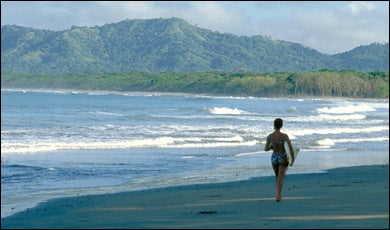
So you want to learn to surf. You want to experience the good-vibrations, enlightened-oneness-with-Mother-Ocean thing, but you’ve outgrown the sleep-under-the-pier, suffer-for-your-wisdom technique. Besides, more than simply learning to hang ten, you’d like someone else to make breakfast, fold the towels, and dial you in to the local scene. For this you’ll need a guide—and the man to see in Costa Rica is Alvaro Solano.
HQ is Vista Guapa Surf Camp, which 28-year-old Solano opened in September 2002 above the Pacific coast town of Jacó. Three sunny duplex casitas cascade down a narrow ridge, pointed right at what may be Costa Rica’s most reliable surf break. Each air-conditioned surf shack is aligned to ensure unimpeded valley views and discreet distance from fellow guests. There are no more than a dozen surfers during each weeklong session, and though you’re only a ten-minute walk from Jacó’s main drag, it’s easy to forget there’s anyone else in the valley when you’re on your deck. From the beach below the lodge, Solano took his first rides on a broken plank as a kid and polished the moves that have made him Costa Rica’s four-time-consecutive national surf champion. He picked this spot for his camp because it offers a beginner-worthy break with waves that average three to four feet—yet advanced-rider hot spots like Boca Barranca, the world’s third-longest left, are nearby.
Though it’s not quite sink or surf, the Vista Guapa doctrine emphasizes learning by doing. Classes are taught by Solano or Lisbeth Vindas, a three-time national champion; I had just one fellow pupil for my first attempt at the sport. Solano showed us how to count wave sets and mark reference points for the likeliest takeoff spots—and then let the waves do the instructing. At first, I waited, watching the ocean and letting my mind wander before turning, taking a few strokes, and dropping in. Solano’s approach worked: I caught the first wave I pursued.
Soon I’d found my own rhythm, on and off the board. I slept in each morning, missing the 6:30 sunrise and the dawn asana session on the outdoor yoga deck but rising in time to shuffle over to the main lodge for the monstrous breakfast of beans and rice, omelets, and fruit, during which Solano ticked off tide times and entertainment options. Each day passed in a blur of watching and paddling, and soon enough we’d start debating the big question of the day—where to have dinner—wrestling between the pan-seared tuna at Playa Hermosa’s Jungle Surf Cafe and Juanita’s seafood platter over in Playa Herradura.
Surf’s up a maximum of four hours daily, which leaves ample time for the multisport cornucopia within an hour of town—Class III-IV whitewater rafting on the Naranjo River and zip-line tours of the forest canopy, for starters. Learning that extreme leisure is the necessary counterpoint to surfing, I started easy, hopping in Solano’s minivan for the tranquillo cruise south to Parque Nacional Manuel Antonio. There I met the surfer’s spirit animal: a three-toed sloth, slung like a sack of mangoes from a branch. But most afternoons were spent in my hammock, where I found myself able to spend hours meditating about which flip-flops to buy.
My big breakthrough came on the fourth morning. Straddling my board, watching the sets roll in, I experienced a moment of the transcendent clarity I’d always imagined would come from being one with the ocean. Suddenly it was all very clear: I could have the shrimp and the lobster for dinner.
DETAILS:
Lodging: The Vista Guapa Surf Camp (011-506-643-2830, ) charges $675 per person per week, $1,200 for two people, including twice-a-day surfing at one of 22 surf breaks, lodging, breakfast and dinner, rentals, and field trips to attractions.
Sports: The surfing around Jacó is consistent year-round. Green Tours (011-506-643-2773) offers a gamut of nearby outfitted adventures.
Liquid Samba
Surf to the Rhythm of Bahia, the Soul of Brazil
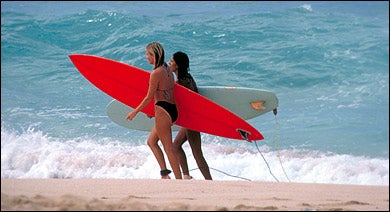
“Did you hear the big news?” my surf instructor, Adriano dos Santos Sarmento, asked when I arrived in the sleepy Brazilian fishing village of Itacaré. “The fishermen caught three massive tiger sharks—right where we’re taking you to surf tomorrow.” Then he added, “The price of shark meat went down 200 percent today.” This Peter Benchley info-moment got my attention, but because shark attacks are unheard of here, I was undeterred from my plan to enlist in surf boot camp.
I ventured to Itacaré, in the eastern coastal state of Bahia, 186 miles south of Salvador, because Brazilian friends told me it possesses the “soul” of Brazil and a legacy of African-influenced music, cuisine, dance, and religion. The Afro-Brazilian culture, they said, imbues Bahia with a mysticism that affects the spirit and the senses—and, I figured, maybe the surf.
The road to town was paved five years ago, not long enough to have made Itacaré a jaded tourist area. And having noted the dreamy look in the eyes of graduates lounging around EasyDrop, a six-year-old surf camp, I set my own goal as nothing short of spiritual deliverance. For the next two weeks, seven multilingual instructors—led by the owner, German ex-fencer and musician Hans-Benjamin Kromayer—would take me and five other recruits (two Brazilians, two Canadians, and a fellow American) to half a dozen of the best surf spots in a 20-mile radius.
I quickly fell into the routine. Classes began with jumping jacks on the white sand. “Choose your wave carefully and always pay attention. Abaixa mais,” Sarmento said, seamlessly mixing English and Portuguese. His suggestion to stay low came right before my surfboard jettisoned me, making me wish that I hadn’t skipped so many balance-building yoga sessions back home.
When I needed a break, I paddled out on my longboard and meditated on the warm, poochy swells that trundled in. May through July, the waves would be eight feet high, not the three feet they were in January, and ten times as intimidating. The mile-long beach, cupped by lush Atlantic rainforest, was deserted except for a little girl decapitating coconuts and selling them to surfers.
Every morning as I strapped on my leash, I swore that I would take the afternoon to raft the nearby Río de Contas or explore the mangrove swamps. But after four hours of surfing, I invariably collapsed into a lactic-acid-induced nap. Only when the heat lost its chokehold on the day did I rouse for the evening video screening—a ritual replete with a professional critique from Kromayer. Then we fueled up on moqueca (a whitefish drenched in a thick coconut and palm-oil broth and served over rice) at Tia Deth, a family-run restaurant with homemade oil paintings tacked to the walls.
“God, this is perfect,” a fellow surfie said at dinner, setting down his caipirinha, a Brazilian cocktail. I didn’t know if he meant the exquisite blend of sugarcane booze and lemon, the tropical breeze that tumbled over the bows of small wooden boats and onto our rickety table, or the delicious soreness of well-used muscles. It was all perfection.
DETAILS:
Lodging: EasyDrop (011-55-73-251-3065, ) offers a two-week package of instruction, lodging at a pousada, and breakfast for $817-$859, depending on the season.
Sports: Mid-September through December and March through April are the best times for beginning surfers to visit. Get surf gear at Pousada Hanalei (daily surfboard rentals, $7-$11; 011-55-73-251-2311). For rafting the Class III-IV Río de Contas, try AtivaRafting (011-55-73-251-2224, ). A 17-mile trip from the put-in at Taboquinhas, in the Itacaré district, costs $14 per person.
Hawaii 911
Who Better Than Firefighter Surf Gods to Initiate Novice Riders?
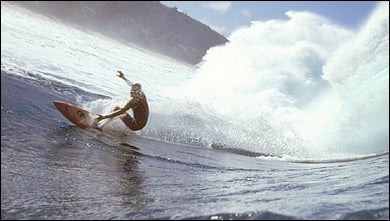
Neophyte surfers cowed by the Pacific’s powerful crush will find comfort in the collective résumé of the 25 teachers at Oahu’s Hawaiian Fire Surf School: They’re Honolulu firefighters certified in every conceivable lifesaving skill—from emergency medical treatment to open-water rescue. More important, they’re born-on-boards guys. They surf almost as frequently as they eat—catching waves before and after work and spending their days off teaching hodads like me. That the trio who coached me last fall were short on attitude, long on skills, and just happened to be built like surf-mag cover gods was a bonus, one certainly not lost on the female contingent of our six-member student body.
Firefighter John Pregil, 40, started Hawaiian Fire Surf School in 2000 with Garrett Vallez and Kevin Miller and two goals: to teach surfing with “aloha spirit” and to do it in an environment of safety. Today, their burgeoning practice has a full lineup of men and women instructors and draws clients from Waikiki hotels; the school runs a free van service out to the near-secret beach where they teach.
That would be Barbers Point, a two-mile strand of southwest-facing sugary-white sand about 25 miles west of Waikiki in Kalaeloa, on the site of the recently decommissioned Barbers Point Naval Air Station. Locals know it, but most surfers prefer bigger quarry than these undaunting one- to two-footers (albeit with nice shape and just enough power to drive a long ride in shallow, 80-degree water). The same conditions make it a great choice for bodysurfers and surf kayakers, and its length and seclusion mean it’s always uncrowded. As a bonus, the point is flanked by Kalaeloa Beach Park, a 13-site campground with picnic tables, showers, and barbecue pits shaded by ironwood trees. Though camping is allowed only on weekends, the area is open for day use during the week.
“The only way you can screw up is by not having fun,” Ken Waters said as he wrapped up our ground-school session. Waters and cohorts Glenn Parker and Mike Jones had given us a thorough briefing on how and when to spring to our feet on superbuoyant foam-padded boards. But to their credit, the teachers didn’t want us bogging down with too much technique. They wanted us to surf.
I had plenty of opportunities for long, smooth rides to shore. I emphasize: plenty of opportunities. I mainly specialized in “pearling” (diving off the surfboard for nonexistent underwater treasures when the nose gets caught in a wave). But, heck, I did get a few rides in and earned the nickname “Big Wave Bob” for my fussiness in wave selection. I also had time to watch the others founder and to surf-gab with my teachers: “You guys are all great surfers. Don’t you get bored with this?”
“Are you kidding?” Parker answered me. “You’re our daily entertainment! And if you get good, we get to surf. Really, we just love to get people stoked. If we’ve accomplished that, then we’ve had a great day.”
DETAILS:
Lodging: The Department of Parks and Recreation (808-523-4525, ) requires a free permit to camp at Kalaeloa Beach Park (Friday, Saturday, or Sunday only).
Sports: Catch the best beginner surf between April and October. Hawaiian Fire Surf School (888-955-7873, ) charges $79 for a half-day group lesson, $97 for a full day, including equipment, lunch (full day only), and transportation from Waikiki. To rent a board ($20 a day), try Blue Planet (808-922-5444, ). The island’s best surf-kayak shop is Go Bananas Kayaks ($30 per day for a single, $43 for a tandem; 808-737-9514, ).


